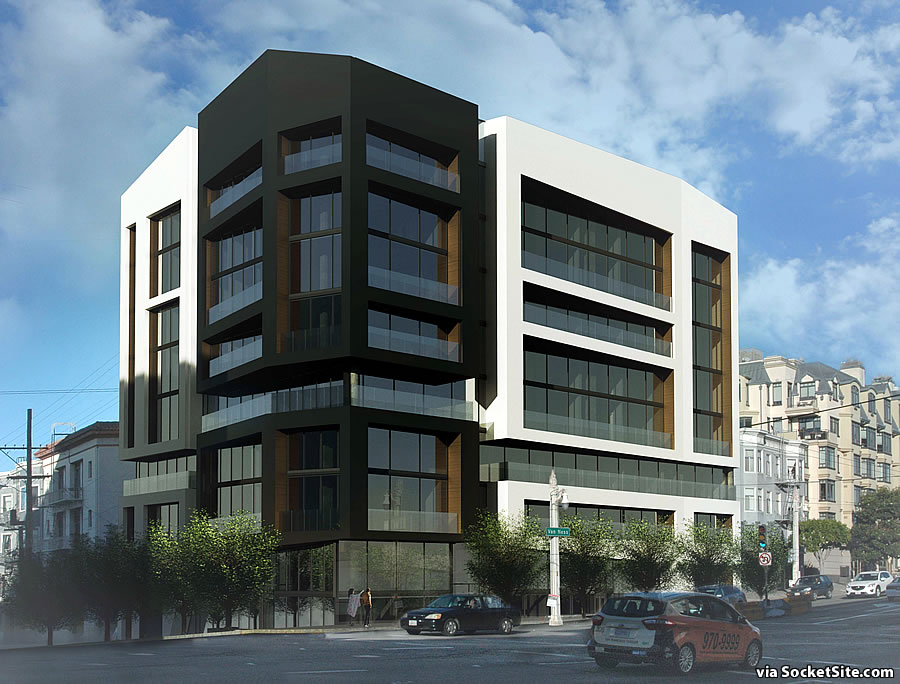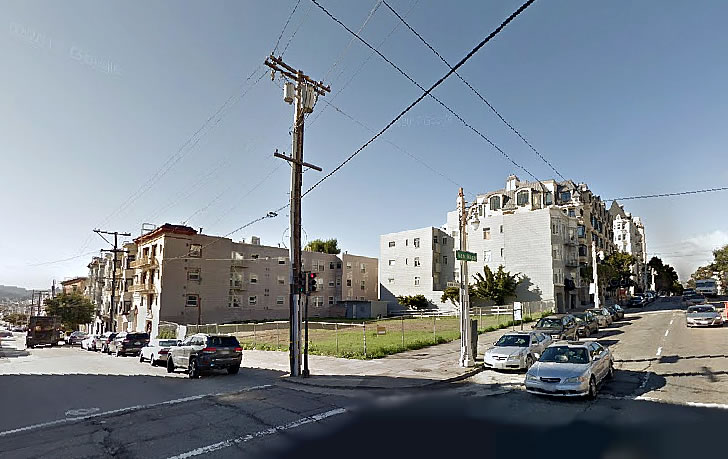As we first reported last week, plans to double the unit density of the approved development to rise upon the former service station site on the northwest corner of Van Ness Avenue and Filbert, on the eastern edge of Cow Hollow, by leveraging San Francisco’s HOME SF program to build up to 85 feet in height upon the parcel which is principally zoned for 20 feet less, are in the works.
And we now have the all-new rendering to reveal:
As redesigned by Costa Brown Architecture and now sporting a contemporary look and feel, the 9-story development would yield a total of 60 condos – a mix of 28 one-bedrooms, 25 twos and 7 threes – over 7,300 square feet of commercial space spread across three storefronts and a basement garage for 70 cars, including 24 spaces for the commercial tenants and one (1) space designated for a car sharing program as proposed.
In order to qualify for the extra 20 feet in height, 18 of the condos (30 percent) would be offered at below market rates (BMR), with 7 units priced for households making up to 80 percent of the Area Median Income (AMI), 5 priced for those making up to 105 percent of the AMI and 6 priced for households making up to 130 percent of the area median.
And as always, we’ll keep you posted and plugged-in.


I’d say this is an improvement, but it doesn’t strike me as very interesting, either.
We are the Borg
Resistance is futile
You will be assimilated
You will service us.
More of this Please!!
VAST improvement from the original design. I look forward to seeing it completed in five or so years.
curiously scale-less
Whoa not quite what I was expecting at this location but hey why not? The key will be in the materials and finishes, If that is 9 floors of stucco then oof! It’s nice to see Van Ness Ave. finally beginning to infill with development at this scale. Geary Blvd. should follow suite.
Muscular. Not that there’s anything wrong with that…
It’s ugly, I hate it! There, It’s said – I feel better now.
I don’t like the exterior, but I’m more interested in how it reflects the interior. The previous design seemed to have lots of small units with individual balconies etc. and a retail entrance on the corner, whereas the new rendering looks like fewer larger units and who knows what happening at street level. I guess I’m wrong based on the unit numbers provided, so are neighbors going to be sharing the balconies peeping in each others’ windows?
I am glad they are going for extra density and height, but it looks like a rather ugly building. My aunt used to work in a 1980’s office building that looked very similar. I thought her old place was rather dreary, and this looks the same. They need to rework the facade and massing—dump the dark panels and don’t recess the windows so deeply. It is a great location, and it needs a better building.
Frightening looking. A solid FU to San Francisco.
This is the same designer as the 388 Beale St project from years ago…
Hopefully Species 8472 will take care of the problem (I am such a nerd)
I think balconies are overrated especially in a low-rise building along a very congested road like Van Ness. Who would use these balconies, occasional smokers? I would have preferred to see interior living space of these condos be increased. More money to the developer and the home owners get to enjoy bigger living area.
As someone who lives on Van Ness and has stepped out onto my balcony once in three years, I can attest that balconies on buildings fronting this street are useless and waste precious space that could go to the interior living area instead. The noise and pollution are terrible, and even if you clean your balcony regularly, it still looks filthy, so one can only imagine how unhealthy the air is to breath.
So perhaps the solution should be clean the air? Not lock people in apartments with no access to outside?
No, the solution is to not build balconies. While clean air is always an issue in city living, the point here is not about air quality. It is about maximizing living space efficiency and our argument that building balconies in low-rise buildings in a congested area is not ideal. Re: accessing to the outside, they can build a rooftop with green space or you can just walk outside from the building (?).
Pablito, that is a great solution. Take that up with Trump’s EPA who is proposing to cut fuel efficiency standards along with gutting other environmental controls.
Also, our building shares a features in common with every other building in SF–doors. I go outside multiple times a day and enjoy the neighborhood and parks on foot.
Also, in my case, having a significantly bigger bedroom would be far more desirable than having a cramped balcony that I cannot use without risking lung cancer.
So, for those of us living in the real world–windows and doors work nicely and give us all the “access” we need. Bigger bedrooms are what we would really appreciate.
The 9 story building trying to look like a 3 story building trick
Not thrilled with the design and lack of detailing, but than again the building shown two blocks to the right side begs for a rehab…. (too faux)
I agree with ‘Chris’ – This looks like an awful Office Building in Silicon Valley built in the late 1970’s … really awful
Everything about the design is over scaled. Double wide and double high windows. Triple long balconies. Quadra high building shrouds. If they reduced the facade on a copy machine by 30%, I think it would fit better with the neighborhood.
Looks like a Medical Office Building, not a residence…Tell the developer CPMC is further south on Van Ness…It will fit in perfectly there….
Does this mean it will definitely be an extra 20 feet higher? If so, this would really s**ck for higher up residents in buildings up Filbert and on Polk that expect views of the bridge and bay. Can developers obstruct existing owners’ views?
Yes, they can. Views are not protected.
Wow cool. Something different.
Definitely does not look like the multitude of beige stucco boxes with square bay windows and yellow color highlights taking over the Mission.
Hope it gets approved.
The housing is needed. The car parking (70 spaces) seems excessive and will further exasperate congestion and pollution along this soon-to-be BRT corridor, while hastening climate change in our sea level city.
I’m confused by your statement. On one hand, you’re encouraging housing to be built, but hate the fact that it promotes congestion, pollution and contributes to climate change. How about this instead…building housing, but invest equally in infrastructure, like some serious mass transit, providing a reasonable alternative to owning a vehicle. Van Ness BRT is a Band-Aid and will do little to attract new riders.
I have more faith in Van Ness BRT, but otherwise I couldn’t agree more, Mark. We are shortchanging the environment and our future by not adequately investing in environmentally sustainable and efficient transportation infrastructure. Our society can afford to invest in first class mass transit but we generally choose not to. By building housing with great amounts of parking, especially in urban environments, we perpetuate and worsen the mess we’re in. The housing isn’t the problem, but the parking spaces and the transportation they facilitate are.
“hastening climate change in our sea level city”. Actually most SF is on hills well above sea level.
And while the Marina, Mission Bay, Millennium tower landfill areas of the City are all sinking, the parts of the City built on bedrock are actually slowly rising due to plate techtonics.
Want to reduce climate change causing pollution? Clean up the 20 year old stinky MUNI diesel buses.
The price tag to protect SF from sea level rise is in the billions. If we get our act together, it’s cheaper to take action to prevent its severity than to mitigate its impact. As to Muni buses, the SFMTA is pretty far along in the process of replacing all buses in their fleet. Aside from that, public transit is a big part of the solution and not the problem. Per passenger mile, bus transportation has a much smaller carbon footprint than that of automobiles.
Mark is correct, the band-aid infrastructure approach waiting for Godot… Sb827 will plop a ton of these through out SF and the traffic mess will follow as cars crisscross SF to get downtown or out to their south bay jobs.
The need for the housing is there but the HOMESF team needs to realize we don’t want monsters next to minis, create a balanced approach or leave it…
Chuck…views are not protected. This is a city.
This looks a lot like the building at Clay & Van Ness, with white wings.
how many ways can you say ugly?
In order to pay for affordable housing, the 30% Below Market Rates units, the hapless developer must make the other 70% of the units more unaffordable. Raising the price of unaffordable housing to make affordable housing. That is the complete and utter stupidity of affordable housing regulations.
That’s a common misunderstanding and mythology. While higher costs, such as in the form of subsidies, do impact a developer’s bottom line, and could result in a project not making financial sense to pursue, developers charge as much as the market is willing to bear. And it’s actually the buyers which set the price, regardless of what it costs to build.
Which means if the price that the buyers of the market priced units are willing to pay is too low to generate a profit for the developer the project does not pencil out and thus no units get build… so yes, the construction costs and developer profits has to be paid by somebody.